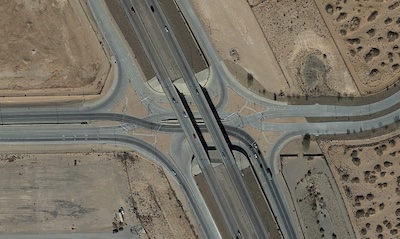
The Road to Success: One Alum’s Career in Traffic Engineering
As you drive to the gym or the grocery store, you might not take the time to think about how streets work, unless you get back-to-back red lights when you’re late for work. But for Jorge Martinez, a UTEP civil engineering alumnus, helping to ensure traffic flows smoothly and safely is his job.

As a senior project manager for HNTB Corp., an infrastructure solutions firm that works to deliver reliable and safe transportation options, Martinez has engineered complex projects supporting El Paso’s traffic system.
“To be a traffic engineer is pretty exciting,” Martinez said. “If you’re looking at a building, you can’t see all the beams or the interior unless it’s exposed. With traffic, you can clearly see the roads, but it’s just your day-to-day, right? It’s exciting because I can see how it affects the day-to-day of not only my life but trying to help everyone out on the construction side [for upgrades].”
Martinez graduated from UTEP with his bachelor’s and master’s degrees in civil engineering in 2008 and 2010, respectively. As a student, he never imagined working as a traffic design engineer, but conducting research with transportation research expert Kelvin “Ruey” Cheu, Ph.D., opened his eyes to this possibility. As a graduate student, Martinez’s thesis focused on freeway infrastructure.
“I had the pleasure of working with Jorge Martinez when he was an undergraduate research assistant, and then as a graduate student, and more recently, as the industrial liaison for the Institute of Transportation Engineers UTEP student chapter,” Cheu said. “He was the first transportation engineer to prove, via his thesis research, that it was possible to build a double crossover diamond interchange at a freeway with frontage roads.”
When driving through a double crossover diamond interchange, traffic crosses in opposite directions on frontage roads than the traffic crossing on a freeway over- or underpass. From an outside perspective, this may look as if a driver is driving on the wrong side of the road, but when implemented correctly, this type of interchange can be used to create unopposed left turns and other time-saving methods. While diamond interchanges are frequently used in freeway design, a double crossover diamond interchange incorporates traffic on frontage roads with traffic on the freeway, allowing for through movement for all drivers.
“Jorge has not only demonstrated his strong desire to improve himself, he is also leading fellow engineers in the industry and inspiring the engineers-to-be,” Cheu said.
As a civil engineer in the transportation industry, no two days are the same. Some days, Martinez finds himself supporting traffic projects, while on others, he works on impact reports detailing how new developments may affect things like traffic and parking.
“I may analyze an intersection one day to determine if a traffic signal may be more efficient than a stop sign and the next be out in the field to check potential signal locations and identify any underground utilities that may impact upgrades,” Martinez said.
When tackling long-range impact studies, Martinez and his team work with different institutions to gauge the impact new developments like stores will have in the community.
"We'd conduct an extensive study encompassing the area within a one-and-a-half-mile radius of the project to assess its potential impacts," Martinez explained. “This study would include evaluating ingress and egress points, analyzing peak traffic hours and recognizing commuting patterns. For instance, if most people are heading to UTEP in the morning and departing in the afternoon, it becomes evident where traffic congestion is likely to occur."
Using this information, Martinez and his team put together studies that help to determine if new developments will be too disruptive and what solutions could be implemented to alleviate the potential issue.
One such project that Martinez worked on, which brings him the most pride in his career, is Southwest University Stadium. When the city announced plans for its development, many El Pasoans felt concerned about how it would impact traffic and parking downtown. He worked with stakeholders to make sure a variety of challenges were addressed.
“I was fortunate to work on a traffic signal project when the baseball stadium was going to open,” Martinez said. “With the stadium’s arrival in downtown, a common concern arose about parking availability. I got involved to identify suitable routes for stadium-goers and asses both public and private options.”

Their work helped to prepare for the influx of traffic to and from the games and for the city to plan for parking accommodations that helped to make the stadium opening a success.
“There was a lot of work that was done, but I think for the most part, even during the first season, people were happy,” Martinez said.
Sometimes Martinez’s work includes huge projects like the opening of the baseball stadium. Other times, it’s as simple as timing and ensuring traffic signals work in a logical order. But either way, the work he and his team accomplish impacts our lives every day.
“It’s trying to balance everyone’s needs and trying to come up with the design that best fits within a community,” Martinez said. “It’s a work of art.”
Last Updated on November 15, 2023 at 12:00 AM | Originally published November 15, 2023
By Julia Hettiger UTEP Marketing and Communications
